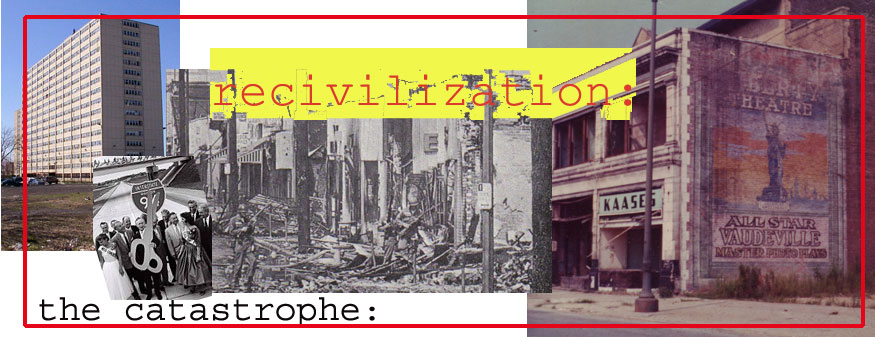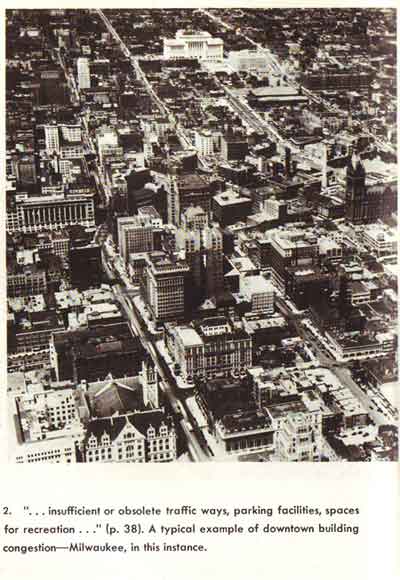

307 urban renewal
It was hardly a new idea. Urban renewal schemes have been with us at least since Emperor Trajan cleared the worst of the Subura, Rome's central slum, for his grand forum and market in 107 ad. Old precedents existed in America too; when Boston redeveloped its center with the Quincy Market in 1825, the city bought all the land around the site, reselling it to developers with the provision that they build in a way harmonious with the project. Now, for cities on the defensive, urban renewal seemed to be the great hope. American society had never really known the uncomfortable feeling of decay, and the way Americans discussed it reveals much about the highly motivated, actively paranoid postwar state of mind. The cliché to sum up all urban problems, real and imagined, was 'blight'. If not checked, blight would spread-the homefront equivalent of the domino theory. Geographer Edward Relph, in The Modern Urban Landscape, notes that medical analogies were also much favored; blight was a disease, a cancer, and all of the 'infected' part had to be scraped out. Congress launched urban renewal with the Housing Act of 1949, a bipartisan effort conspicuously co-sponsored by Mr. Liberal, New York's Robert Wagner, and Mr. Conservative, Robert Taft of Ohio, along with southern Democrat Allan Ellender. Every interested group lobbied strongly for it: the National Association of Real Estate Boards, the US Savings and Loan League, all the building and development interests and Chambers of Commerce. The architects, who saw prospects for plenty of work, thumped the tub louder than anyone. No group lusted more strongly for massive demolition; in New York, the local AIA was calling for the obliteration of lower midtown Manhattan, nearly everything between City Hall and 23rd Street.. Urban renewal seemed a logical continuation of the New Deal's efforts. The only people who might have objected, had they been consulted, were the residents of the targeted areas. Most seem to have had no idea what was about to happen to them, although merchants in Washington's Southwest area dragged the Housing Act up to the Supreme Court. There, in 1954, William O. Douglas wrote the opinion that 'it is within the power of the legislature to determine that the community should be beautiful as well as healthy, spacious as well as clean, well-balanced as well as carefully patrolled'. Bulldozers around the nation went to work a few weeks later. Many of the 'blighted' neighborhoods targeted by urban renewal were in fact quite livable places, safer and better-maintained than the average inner-city district today. The planners provided the proof of this themselves. Federal guidelines that mandated city planning fostered a common approach in survey techniques. Search the libraries, or the planning records of almost any city for the 40's and 50's, and you will find a set of look-alike maps divided by census tract, showing such statistics as density and housing deterioration. The worst areas, those doomed by the programs to come, will often show only 10% or 20% of buildings rated as 'substandard' or 'deteriorated'; even where the percentages were higher, under the definitions of the time, this could have meant only the lack of fresh paint or up-to-date plumbing. Nevertheless, at the time they were perceived as a threat to downtown real estate values. In urban renewal, as in housing, the new caste of experts would finally get a chance to show what they could do. When they were out of the government and back at the university for a spell, some of them wrote books, and a quick look at any of them is enough to grasp the juvenile utopianism that fueled the whole business of 'conscious planning for better living'. We are shown an air photo of downtown Milwaukee in the 40's-the grand old City Hall, Wisconsin Avenue alive with shoppers, plenty of neon roof signs; little old buildings and big new ones peacefully coexisting, close-in residential neighborhoods all around. The caption beneath it reads: '...insufficient or obsolete traffic ways, parking facilities, spaces for recreation...A typical example of downtown building congestion.' This was the enemy, and the planners went after it with gusto. The first phase covered some 1,400 projects in 700 cities. Often, no developers had been lined up for any of the cleared land, and urban renewal became simply a pretext for demolition, especially in black areas. Nationwide, thousands of acres cleared in the 50's and 60's remain vacant to this day. As many as one million people were chased from their homes, and despite all the disclaimers, the hidden agenda of the planners and politicians was clear- 80% of the displaced were black. The ink was hardly dry on the first-phase plans before protesters started calling them 'Negro removal' projects. Local authorities consistently selected black areas for flattening over central white neighborhoods comparable in population and housing condition. In all, urban renewal destroyed an estimated 383,000 units of housing from 1949 to 1967, and replaced them with only 107,000 new ones; of these, only 10,000 were low-income [urban renewal destroyed: statistics from Jakle and Wilson, p. 132.] Typically of federal programs, nobody knows for sure what the real figures are; some estimates put the number of the destroyed units as 425,000, which would mean about a million and a half refugees. Demolition also meant losses to people's livelihoods; by 1971 some 100,000 businesses had been evicted, most of them small independent shops and services. Various estimates of the number that subsequently failed range from a third to half. Every city has its own story to tell, but the particular case of Memphis' Beale Street district exemplifies the strange, two-headed nature of federal policy. In honor of W. C. Handy and his fellows, two blocks of Beale Street itself were eventually declared a National Historic Landmark, protected by the government. The rest, 625 buildings in all. had already been rubbed out with federal funds, and left largely vacant. One of the most flagrant Negro removal projects was Cincinnati's Kenyon-Barr, where 25,000 blacks living uncomfortably close to downtown were tossed out for nothing better than light industrial uses. In Cleveland, when the customers of the major uptown business and entertainment district, around Euclid and E. 105th, became largely black, the city arranged for its disappearance with the University-Euclid plan, in order to isolate and protect the adjoining cultural institutions at University Circle. All too often, 'blight' was simply a euphemism for black faces on the street. All urban renewal plans had to be approved by Washington, but there is no indication that the government ever voiced any opposition to such behavior. In practice, federal control only assured adherence to bad academic design and the impossibility of innovation. Plans made for renewal areas show all the delusions of Modernism made manifest: the sacrifice of the urban street system for superblocks, faceless buildings, blank walls, big-project mentality, paper planning and paper architecture. It was stupidity on a massive scale, and only a touching devotion to dogma could have kept planners and architects from noticing that it was all going very wrong. As William H. Whyte noted, it was a time when cities had one evident success, the unplanned, spontaneous revitalization of old row house neighborhoods by individual private efforts, as in Brooklyn Heights and Washington's Georgetown. Still, no planners ever considered encouraging this model, preferring instead massive clearance followed by apartment towers and garden apartments built to hellacious caricatures of architecture and design. One of the greatest sins of urban renewal was the timing. Areas would be designated, and then nothing happened for years while the slow federal approval process ground on. Under such circumstances, code violations were winked at and landlords had no incentive to do anything but milk the maximum profit from their buildings. So cities developed scary zones of half vacant lots, half rotted-out buildings, with disastrous effects on neighboring districts. In some places, urban renewal proved as good at creating permanent slums as demolishing them: in Rockaway, Queens, the ill-conceived and executed Arverne-Edgmere plan dragged over eight years while disinvestment turned beach paradise into New York's most inexplicable slum. In almost every city, projects had incredibly destructive effects on other neighborhoods, starting chain reactions of movement through the city as the displaced, mostly poor blacks, sought out new homes elsewhere. Usually, they would be steered to certain areas by tacit conspiracies of local lenders, realtors and government. With the aid of blockbusting and disinvestment, this rapidly created new slums. In Washington, people pushed out for the Southwest project ended up in low-value neighborhoods across the Anacostia River, a remote place where blacks were dumped to assuage white segregationist fears that they would flood the rest of the city. This area, south of Pennsylvania Avenue, had 79,000 people in 1950, 82% white; by 1970, though the District population was falling, there were 126,000, 85% of them black; altogether it was the most successful case of a city actually picking up a ghetto and moving it intact. Chicago provides us with another clue as to what was really happening in all the storm and fury of the era. South Side potentate Bill Dawson had helped Richard Daley get elected, but Daley, fearing any black who commanded political power, stabbed him in the back by literally tearing down his power base-the urban renewal scam perfected, with a political twist. Daley cronies made fortunes by speculation and urban renewal work, in such projects as the Taylor Homes, while Dawson's supporters, now refugees, were mostly forced into the West Side, into wards where Daley had his own stalwarts in charge. Such shenanigans didn't come cheap, and the federal government only paid for a limited share of urban renewal. The rest had to be supplied by the cities themselves, contributing mightily to their financial problems. In Boston, the perfect marriage of liberal Mayor John Collins and star redeveloper Ed Logue saw the destruction of the diverse and lively West End for a miasma of ghastly projects and skyscraper boxes. This and other plans included big tax concessions for the new developments, and to offset them the administration had to raise property taxes in four consecutive years while slashing public services, sinking Collins' political career. His successor, Kevin White, would eventually fall victim to the next cycle of downtown ambitions and tax hikes. Boston had always looked to the best and the brightest, and this time they let her down. The influence of the planners and social experts at MIT and Harvard helped teach Boston to think technocratically, and to favor the most radical extremes of Modernism. The result in urban renewal was mass dislocation and architectural atrocity, particularly in the West End; in public housing, it meant projects like the notorious Columbia Point, and in transportation it was exemplified by the Central Artery, the downtown elevated highway that Boston has just spent twelve billion dollars to remove. The postwar era marked the first major lapse in Boston's proud record of city-building, and her experience highlights the way that major elements of the Catastrophe-technocracy, utopian architecture and federal intervention-worked to drag all cities down to the same level. See a neighborhood (Hyde Park-Kenwood, in Chicago) tell its own urban renewal horror story in meticulous detail at: http://www.hydepark.org/historicpres/urbanrenewal.htm |
|

|